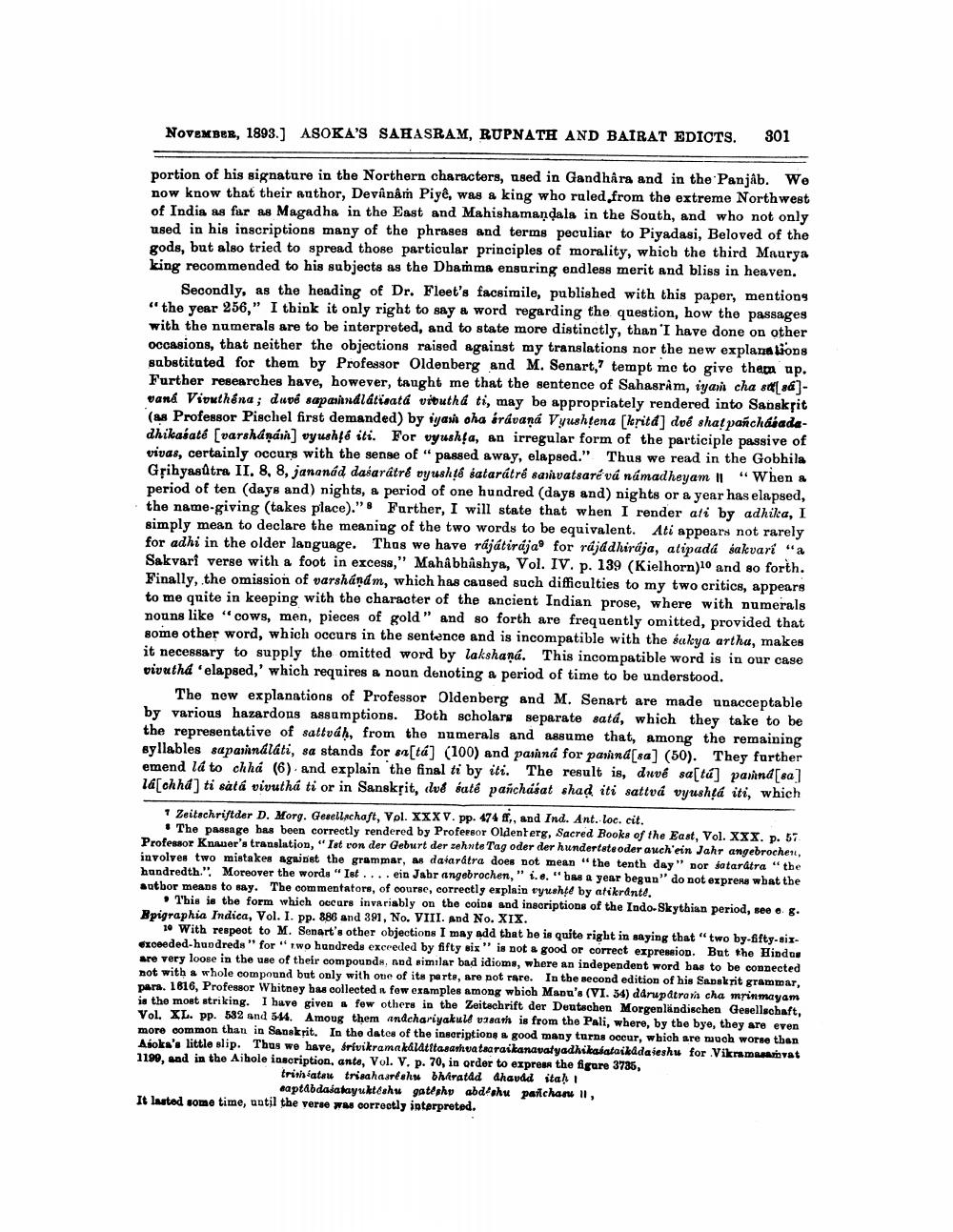________________
NOVEMBER, 1893.) ASOKA'S SAHASRAM, RUPNATH AND BAIRAT EDIOTS.
301
portion of his signature in the Northern characters, used in Gandhåra and in the Panjậb. We now know that their anthor, Devânâm Piyê, was a king who ruled from the extreme Northwest of India as far as Magadha in the East and Mahishamandala in the South, and who not only used in his inscriptions many of the phrases and terms peculiar to Piyadasi, Beloved of the gods, but also tried to spread those particular principles of morality, which the third Maurya king recommended to his subjects as the Dhamma ensuring endless merit and bliss in heaven.
Secondly, as the heading of Dr. Fleet's facsimile, published with this paper, mentions "the year 256," I think it only right to say a word regarding the question, how the passages with the numerals are to be interpreted, and to state more distinctly, than 'I have done on other occasions, that neither the objections raised against my translations nor the new explanations substituted for them by Professor Oldenberg and M. Senart," tempt mo to give them up. Further researches have, however, taught me that the sentence of Sahasram, iyazi cha st(sd) - vaná Viduthéna; dupe sapaindlátiratá vitutha ti, may be appropriately rendered into Sanskțit (as Professor Pischel first demanded) by iyan gha órávaná Vyushtena (kritd] doé shat pañchásadadhikabaté (varsháñán) vyushfé iti. For vyushļa, an irregular form of the participle passive of vivas, certainly occurs with the sense of " passed away, elapsed." Thus we read in the Gobhila Grihyasūtra II. 8, 8, jananád dasarâtré vyushte satarátré saivatsaré vá námadheyam | "When a period of ten (days and) nights, a period of one hundred (days and) nights or a year has elapsed, the name-giving (takes place)."8 Further, I will state that when I render ali by adhika, I simply mean to declare the meaning of the two words to be equivalent. Ati appears not rarely for adhi in the older language. Thus we have rájátirája for rújddhirája, atipadá sakvari "a Sakvari verse with a foot in excess," Mahâbhâshya, Vol. IV. p. 139 (Kielhorn)10 and so forth. Finally, the omission of varsháňám, which has caused such difficulties to my two critics, appears to me quite in keeping with the character of the ancient Indian prose, where with numerals nouns like "cows, men, pieces of gold" and so forth are frequently omitted, provided that some other word, which occurs in the sentence and is incompatible with the sakya artha, makes it necessary to supply the omitted word by lakshaná. This incompatible word is in our case vivutha 'elapsed,' which requires a noun denoting a period of time to be understood.
The new explanations of Professor Oldenberg and M. Senart are made unacceptable by various hazardons assumptions. Both scholars separate sata, which they take to be the representative of sattváh, from the numerals and assume that, among the remaining syllables saparindiati, sa stands for sa[tá] (100) and paina for parind[sa] (50). They further emend la to chha (6) and explain the final ti by iti. The result is, duve sastál parind[8] 14 chha) ti sátá vivutha ti or in Sanskrit, dve éaté panchasat shad iti sattvá vyushtá iti, which
* Zeitschriftder D. Morg. Gesellschaft, Vol. XXXV. pp. 474 ff, and Ind. Ant. loc. cit.
• The passage has been correctly rendered by Professor Oldenterg, Sacred Rooks of the East, Vol. XXX. p. 57 Professor Knager's translation, "Tot von der Geburt der zehnte Tag oder der hundertete oder auch ein Jahr angebrochen, involves two mistakes against the grammar, as dataratra does not mean "the tenth day" nor dataratra "the hundredth.". Moreover the words "Ist .... ein Jabr angebrochen," i.e. "bes a year begun" do not express what the autbor means to say. The commentators, of course, correctly explain ryushte by alikrante.
This is tbe form which occurs invariably on the coins and inscriptions of the Indo. Skythian period, see . 8. Epigraphia Indica, Vol. I. pp. 886 and 391, No. VIII. And No. XIX.
10 With respeot to M Senart's other objections I may add that he is quite right in saying that "two by-fifty-sixciceeded hundreds" for "wo hundreds exceeded by fifty six" is not a good or correct expression. But the Hindus are very loose in the use of their compounds, and similar bad idioms, where an independent word bas to be connected not with a whole compound but only with one of its parte, are not rare. In the second edition of his Sanskrit grammar, para. 1616, Professor Whitney has collected fow examples among wbioh Mapu's (VI. 34) ddrupdtrai cha mrinmayam is the most striking. I have given fow others in the Zeitschrift der Deutschen Morgenlandischen Gesellschaft, Vol. XL. pp. 532 and 544. Amoug them andchariyakult visats is from the Pali, where, by the bye, they are even more common than in Sanskrit. In the dates of the inscriptions a good many turns occur, which are much worse than Asoka's little slip. Thus we have, Srivikramakalatitasashuateraikanavatyadhikabataikddaieshu for Vikramaavat 1190, and in the Aibole inscription, anto, Vol. V. p. 70, in order to express the figure 3785,
trishiatsu trisahasresh bharatad dhavdd ital
aaptabdasatayukteshu gateshy abdshu partchant II, It lasted some time, until the verse was correctly interpreted.




